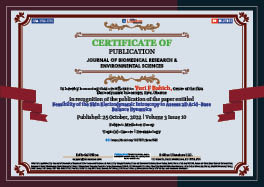Yuri F Babich*, Efim M Roytman and Andrey Y Babich
Volume3-Issue10
Dates: Received: 2022-10-11 | Accepted: 2022-10-24 | Published: 2022-10-25
Pages: 1233-1239
Abstract
Synchronization is a universal phenomenon that occurs at all levels of the existence of living and inanimate matter. Shortly after enabling monitoring of the electrical impedance landscape of the skin, such phenomena were detected as dynamic clusters with in-phase and anti-phase dynamics. The behavior of these clusters turned out to be very sensitive to various endogenous and exogenous factors and was especially pronounced, for example, at the melanoma areas. Hypothesis of the acid-base balance fluctuations have been put forward as one of the most likely mechanisms for this phenomenon, since hydrogen ions are one of the main factors that determine tissue electrical conductivity. The purpose of this study was to obtain experimental evidence for this hypothesis. The 2D dynamics of glycolysis metabolism was studied on a yeast model as an adequate model of cancer cells. The image sequences reflected the dynamics of processes occurring at the intercellular and intracellular levels, in the form of current values of the 2D active and capacitive components of the impedance in the range of 2 kHz and 1 MHz. As a test factor, a single drop of glucose was used. The revealed effects of clusterization were found similar to those obtained earlier in human experiments. Specifically, these effects were also clearly manifested in the affected region. At the same time, the intercellular medium turned out to be the most rapidly responsive, while the intracellular response occurred with a significant delay but without so marked manifestations of anti-phase behavior. The observed effects are presumably a macroscopic manifestations of quorum sensing mechanisms and cooperative wave processes. We believe that the developed technology can be used as an inexpensive and non-invasive tool for both In vivo and In vitro real-time pH monitoring.
FullText HTML
FullText PDF
DOI: 10.37871/jbres1583
Certificate of Publication

Copyright
© 2022 Babich YF, et al. Distributed under Creative Commons CC-BY 4.0
How to cite this article
Babich YF, Roytman EM, Babich AY. Feasibility of the Skin Electrodynamic Introscopy to Assess 2D Acid-Base Balance Dynamics. 2022 Oct 25; 3(10): 1233-1239. doi: 10.37871/jbres1583, Article ID: JBRES1583, Available at: https://www.jelsciences.com/articles/jbres1583.pdf
Subject area(s)
References
- Di Costanzo L, Panunzi B. Visual pH Sensors: From a Chemical Perspective to New Bioengineered Materials. Molecules. 2021 May 16;26(10):2952. doi: 10.3390/molecules26102952. PMID: 34065629; PMCID: PMC8156760.
- Mansoorifar A, Koklu A, Ma S, Raj GV, Beskok A. Electrical Impedance Measurements of Biological Cells in Response to External Stimuli. Anal Chem. 2018 Apr 3;90(7):4320-4327. doi: 10.1021/acs.analchem.7b05392. Epub 2018 Feb 14. PMID: 29402081.
- Urban F, Hajek K, Naber T, Anczykowski B, Schäfer M, Wegener J. PETER-assay: Combined Impedimetric Detection of Permeability (PE) and Resistance (TER) of Barrier-Forming Cell Layers. Sci Rep. 2020 Apr 30;10(1):7373. doi: 10.1038/s41598-020-63624-1. PMID: 32355192; PMCID: PMC7192940.
- Groeber F, Engelhardt L, Egger S, Werthmann H, Monaghan M, Walles H, Hansmann J. Impedance spectroscopy for the non-destructive evaluation of in vitro epidermal models. Pharm Res. 2015 May;32(5):1845-54. doi: 10.1007/s11095-014-1580-3. Epub 2014 Dec 3. PMID: 25467957; PMCID: PMC4381093.
- García E, Pérez P, Olmo A, Díaz R, Huertas G, Yúfera A. Data-Analytics Modeling of Electrical Impedance Measurements for Cell Culture Monitoring. Sensors (Basel). 2019 Oct 25;19(21):4639. doi: 10.3390/s19214639. PMID: 31731413; PMCID: PMC6864697.
- Gerasimenko T, Nikulin S, Zakharova G, Poloznikov A, Petrov V, Baranova A, Tonevitsky A. Impedance Spectroscopy as a Tool for Monitoring Performance in 3D Models of Epithelial Tissues. Front Bioeng Biotechnol. 2020 Jan 24;7:474. doi: 10.3389/fbioe.2019.00474. PMID: 32039179; PMCID: PMC6992543.
- Naumowicz M, Figaszewski ZA, Poltorak L. Electrochemical impedance spectroscopy as a useful method for examination of the acid–base equilibria at interface separating electrolyte solution and phosphatidylcholine bilayer. Electrochimica Acta. 2013;91:367-372. doi: 10.1016/j.electacta.2012.12.093.
- Urban F, Hajek K, Naber T, Anczykowski B, Schäfer M, Wegener J. PETER-assay: Combined Impedimetric Detection of Permeability (PE) and Resistance (TER) of Barrier-Forming Cell Layers. Sci Rep. 2020 Apr 30;10(1):7373. doi: 10.1038/s41598-020-63624-1. PMID: 32355192; PMCID: PMC7192940.
- Babich Y, Nuzhdina M. Visualization of the Skin Electrodynamic Landscape: Some Phenomenological Features in Norm and Oncopathology. In: Proc. of the WC on Medical Physics and Biomedical Engineering. Munich (DE): Springer; 2009. p.1-4.
- Babich Y, Nuzhdina M, Syniuta S. Young and advanced tumor-some 2D electrodynamic distinctions: melanoma and satellite during a vascular occlusion test: feasibility study. Med Biol Eng Comput. 2018 Feb;56(2):211-220. doi: 10.1007/s11517-017-1668-0. Epub 2017 Jul 10. PMID: 28691130.
- Babich Y, Nuzdhina M. New phenomenon in living matter? Clusterization & synchronization of electrodynamic landscape. J Cancer Res Oncobiol. 2019;2:15.






























































